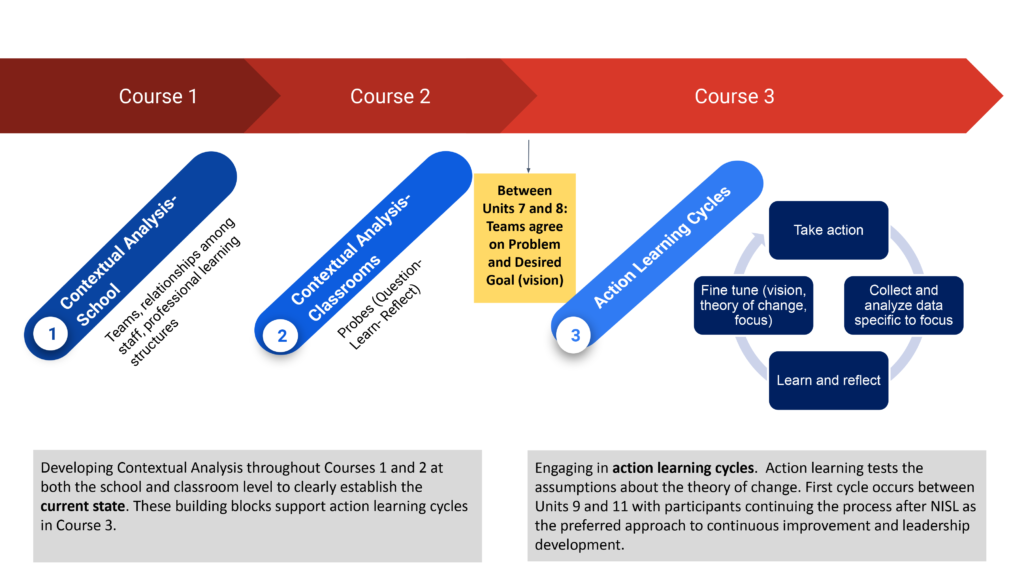
For this segment, you will need the pre-reading, “Action Learning and Leadership Development.” by Volz-Peacock et al., in preparation for several discussions on action learning.
Opening Discussion
In your small group, answer the following questions, finding evidence from the literature:
Be prepared to share your discussion.
1.9.2 Overview of Action Learning in NISL (PIL 2023)The goal of action learning in NISL (PIL 2023) is for graduates of the program to adopt action learning as their preferred approach for continuous improvement and leadership development.
To support this goal, action learning in NISL (PIL 2023) is
The general timeline for those activities follows.

During Course One you will complete a contextual analysis for your school using the Context Analysis Tool and guidance provided.
Note: For Pennsylvania Inspired Leadership (PIL) participants who have completed Course One prior to July 1, 2022, you will use your reports and reflections from the Instructional Leadership Instrument (ILI), Learning Context Assessment (LCA), and High Quality Aligned Instructional System (HQAIS) instead of the Context Analysis Tool as data to include in your contextual analysis.
In Course Two, you will continue working collaboratively with your team to collect data in a series of guided inquiries, called Research Probes, geared toward the content of the units.
You will use this information, along with what you have learned about your school from the Context Analysis Tool, to perform a deeper analysis of your context.
The iterative process of engaging in contextual analysis will support you in identifying a focus for action learning and a refined vision for the organization.
Using the two aids (i.e., Context Analysis Tool, probes) in a robust approach to contextual analysis will enable you to gather valuable information from multiple perspectives across various environments within your school to inform the focus for your action learning in Unit 7.
With a clarified focus for action learning (i.e., the “problem”), in Unit 8 you will engage in the inquiry process within the action learning meeting. After the simulated experience of learning and problem solving within a team, you will learn the critical role and criteria for creating your own action learning team.
In Course Three, you will learn how to collaborate with your action learning teams to perform one full cycle of action learning supported by your facilitator and cohort members.
The cycle of inquiry continues across the rest of Course Three. More specifically:
In preparation for Unit 12, you will retake the Context Analysis Tool and send it to your teams to do the same. Then, with your a ction learning team, engage in the analytical process to determine how your context has changed in your work toward your vision as a result of the action learning process.
Finally, you will share with the cohort final reflections from the learning journey you experienced as a leader and with your team, as well the organizational changes that resulted as you worked toward your vision.
Your facilitator will provide action learning support throughout NISL (PIL 2023) to ensure your school’s success by harnessing the power of inquiry, action, and reflection through strategic thinking.
1.9.3 Strengthening Teams with a Mutual Learning MindsetNow you’re going to delve more deeply into team-related aspects of action learning.
You’ll want to refer to any notes you made on your pre-reading from Chapter 1 of Smart Leaders, Smarter Teams and “Action Learning and Leadership Development” by Volz-Peacock et al.
At the direction of your facilitator, you will work in assigned groups to engage in a text-based discussion of Chapter 1 of Smart Leaders, Smarter Teams using the following questions:
Here is a reminder of the protocol for a productive text-based discussion:
Be prepared to bring your ideas, insights, and questions back to the whole group discussion with your facilitator.
1.9.4 Reflecting on the Current StateEffective action learning depends on an accurate, iterative analysis of one’s context to define the strengths, challenges and gaps that will affect your efforts.
NISL (PIL 2023) provides the Context Analysis Tool and accompanying user guide to assist you with this process.
The Context Analysis Tool is at the heart of your action learning process, so it’s vital that you understand its purpose and use it to your maximum advantage.
This tool, which you reviewed as pre-work for this unit, provides a succinct means for highlighting some of the key factors to be considered.
To support the discussion in this section, please refer to the Context Analysis Tool User Guide, and be prepared to share any questions or observations you had about this guide or the process it describes.
Some key points to bear in mind:
Before you return for Unit 2, you should complete the tool, which includes closed items and open-ended questions. (Make sure you are clear on the meaning and intent of each question.)
Prior to Unit 3, you will be using this same tool to gather input from 4–6 members of your school community with diverse perspectives given their roles and levels of experience.
To this end, you should send the tool and User Guide sooner rather than later to ensure you receive their feedback in time.
When preparing to invite others to take the tool, consider the following questions:
Continual collaboration and communication are necessary for action learning to take root among your school’s team and staff.
As you think about your learning from Section 1.9, which included the importance of having a high-functioning action learning team and the beneficial effects of a mutual learning mindset on team behaviors, reflect individually on at least one of the following questions:
Be prepared to share what you have done in response to the questions when you return for Unit 2.